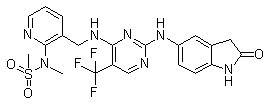PF-562271
别名: PF-00562271
目录号:S2890 Purity: 99.95%
PF-562271 (PF-00562271)是一种有效的,ATP竞争性的,可逆的FAK抑制剂,无细胞试验中IC50为1.5 nM,作用于FAK比作用于Pyk2选择性高10倍左右,比作用于其他蛋白激酶(除了一些CDKs)选择性高100倍以上。

CAS: 717907-75-0
客户使用Selleck的PF-562271发表文献120篇
- Cell, 2019 36(2):179-193
- Cancer Cell, 2019 36(2):179-193
- Nat Cell Biol, 2016 18(2):168-80
- Nat Cell Biol, 2015 17(11):1412-21
- Heliyon, 2024 10(1):e23690
- Nat Commun, 2023 14(1):6270
- Cell Death Dis, 2023 14(2):135
- Cell Rep, 2023 42(5):112529
- J Transl Med, 2023 21(1):530
- Int J Mol Sci, 2023 24(17)13113
- Life Sci Alliance, 2023 6(2)e202201388
- PLoS One, 2023 18(4):e0284871
- Proc Natl Acad Sci U S A, 2022 119(32):e2201328119
- Adv Healthc Mater, 2022 e2200527
- Front Immunol, 2022 13:837180
- Cancers (Basel), 2022 14(6)1537
- J Biol Chem, 2022 S0021-9258(22)00119-3
- Acta Biochim Biophys Sin (Shanghai), 2022 54(2):252-260
- Acta Pharm Sin B, 2021 11(1):143-155
- J Nanobiotechnology, 2021 19(1):175
- Elife, 2021 10e63093
- Eur J Med Chem, 2021 223:113670
- mBio, 2021 12(6):e0322821
- Front Pharmacol, 2021 12:804327
- J Leukoc Biol, 2021 10.1002/JLB.2A0220-127R
- Cancers (Basel), 2021 13(5)1111
- Biomedicines, 2021 9(12)1789
- Sci Adv, 2021 7(40):eabh0363
- Nat Commun, 2020 11(1):3282
- J Clin Invest, 2020 1;130(5):2422-2434
- EMBO Mol Med, 2020 e12010
- ACS Appl Mater Interfaces, 2020 15
- Cell Death Dis, 2020 14;11(4):230
- Cell Rep, 2020 30(6):1780-1797
- Elife, 2020 4;9:e50571
- Cells, 2020 9(1)
- Mol Cancer Ther, 2020 19(2):637-649
- Int J Mol Sci, 2020 21(9)E3214
- Cancers (Basel), 2020 12(12)E3708
- Aging (Albany NY), 2020 7;12(9):8221-8240
- J Biol Chem, 2020 jbc.RA120.012957
- J Biol Chem, 2020 12 pii: jbc
- Sci Rep, 2020 10(1):419
- Cell Cycle, 2020 14:1-13
- Cancer Med, 2020 10.1002/cam4.3621
- Cell Adh Migr, 2020 14(1):153-164
- Biochem Biophys Res Commun, 2020 S0006-291X(20)32148-3
- The University of Texas at Austin, 2020
- Mol Biomed, 2020 1(1):12
- Clin Cancer Res, 2019 25(14):4552-4566
- Cell Death Dis, 2019 10(10):738
- Sci Signal, 2019 12(565)
- J Biol Chem, 2019 294(18):7221-7230
- Molecules, 2019 24(10)
- Oncol Rep, 2019 41(2):1424
- J Cancer Res Clin Oncol, 2019 145(6):1461-1469
- J Pharm Biomed Anal, 2019 168:163-173
- Mol Med Rep, 2019 19(6):4753-4760
- J Tissue Eng Regen Med, 2019 13(4):625-636
- Zygote, 2019 27(3):173-179
- Cell Death Dis, 2018 9(9):848
- Cell Rep, 2018 22(10):2784-2796
- Acta Pharmacol Sin, 2018 10.1038/aps
- Oncogene, 2018 37(22):2953-2966
- Oncogene, 2018 37(23):3166-3182
- Oncogene, 2018 37(16):2197-2212
- Cancer Sci, 2018 109(12):3783-3793
- J Am Heart Assoc, 2018 7(18):e008604
- Int J Oncol, 2018 53(4):1544-1556
- Stem Cells Int, 2018 2018:2190657
- Cell Cycle, 2018 17(23):2577-2592
- Oncol Rep, 2018 40(4):2325-2333
- J Cell Sci, 2018 131(10)
- Biochimie, 2018 150:110-130
- Cancer Epidemiol Biomarkers Prev, 2018 27(7):805-813
- Sci Transl Med, 2017 9(420)
- Nat Commun, 2017 8:14122
- Mol Syst Biol, 2017 13(1):905
- Cancer Sci, 2017 108(7):1347-1356
- FEBS J, 2017 284(17):2856-2869
- Oncotarget, 2017 8(37):61742-61760
- Oncotarget, 2017 8(43):75102-75113
- Oncotarget, 2017 8(29):47931-47942
- Cell Signal, 2017 38:1-9
- Sci Rep, 2017 7(1):4032
- Mol Carcinog, 2017 56(12):2558-2565
- Oncol Rep, 2017 38(1):63-70
- Onco Targets Ther, 2017 10:5817-5826
- Mol Med Rep, 2017 16(6):8937-8943
- Biophys J, 2017 113(7):1585-1598
- Cancer Manag Res, 2017 9:879-889
- Evid Based Complement Alternat Med, 2017 2017:4535326
- Nat Commun, 2016 7:10354
- Clin Cancer Res, 2016 22(23):5851-5863
- Cancer Res, 2016
- Cancer Lett, 2016 376(1):188-96
- Breast Cancer Res, 2016 18(1):81
- Oncotarget, 2016 7(30):48093-48106
- Oncotarget, 2016 7(29):45186-45198
- Oral Oncology, 2016 10.1016/j.oraloncology.2016.05.010
- J Biol Chem, 2016 291(15):8140-9
- Sci Rep, 2016 6:19261
- Sci Rep, 2016 6:36214
- J Proteome Res, 2016 15(12):4369-4386
- Int J Biochem Cell Biol, 2016 71:62-71
- Mol Pharmacol, 2016 89(5):521-40
- Proc Natl Acad Sci U S A, 2015 112(20):E2595-601
- Oncogene, 2015 34(40):5114-27
- Elife, 2015 4
- Mol Cell Proteomics, 2015 14(11):2887-900
- Mol Cancer Ther, 2015 14(10):2238-48
- Oncotarget, 2015 6(27):23776-92
- Oncotarget, 2015 6(28):25755-69
- Oncotarget, 2015 6(3):1531-43
- J Biol Chem, 2015 290(14):8677-92
- Cell Physiol Biochem, 2015 37(2):515-26
- Environ Toxicol Pharm, 2014 39(1):114-124
- PLoS One, 2014 9(2):e88587
- Cancer Sci, 2013 104(12):1618-25
- Int J Clin Exp Pathol, 2013 6(10):2082-91
化学信息&溶解度
| 分子量 | 507.49 |
| 分子式 | C21H20F3N7O3S |
| CAS号 | 717907-75-0 |
| Smiles | CN(C1=C(C=CC=N1)CNC2=NC(=NC=C2C(F)(F)F)NC3=CC4=C(C=C3)NC(=O)C4)S(=O)(=O)C |
| 储存条件(自收到货起) | |
建议分装储备液,避免反复冻融! |
|
| 体外溶解度 | 批次: |
|
DMSO : 100 mg/mL ( 197.04 mM; DMSO吸湿会降低化合物溶解度,请使用新开封DMSO) Water : ˂1 mg/mL Ethanol : ˂1 mg/mL DMSO : 100 mg/mL ( 197.04 mM; DMSO吸湿会降低化合物溶解度,请使用新开封DMSO) Water : Insoluble Ethanol : Insoluble DMSO : 100 mg/mL ( 197.04 mM; DMSO吸湿会降低化合物溶解度,请使用新开封DMSO) Water : Insoluble Ethanol : Insoluble DMSO : 100 mg/mL ( 197.04 mM; DMSO吸湿会降低化合物溶解度,请使用新开封DMSO) Water : Insoluble Ethanol : Insoluble DMSO : 100 mg/mL ( 197.04 mM; DMSO吸湿会降低化合物溶解度,请使用新开封DMSO) Water : Insoluble Ethanol : Insoluble |
|
| 体内溶解度 | 批次: |
| 现配现用,请按从左到右的顺序依次添加,澄清后再加入下一溶剂 | |
|
5%DMSO
40%PEG300
5%Tween80
50%ddH2O
浓度:5mg/ml
(9.85mM)
操作示例:以 1 mL 工作液为例,取50μL100mg/ml的澄清DMSO储备液加到400μL PEG300中,混合均匀使其澄清;向上述体系中加入50μLTween80,混合均匀使其澄清;然后继续加入500μL ddH2O定容至 1 mL。工作液请现配现用!
|
|
摩尔浓度计算器
质量(g)= 浓度(mol/L)* 体积(L)* 分子量(g/mol)
动物体内配方计算器(澄清溶液)
第一步:请输入基本实验信息(考虑到实验过程中的损耗,建议多配一只动物的药量)
第二步:请输入动物体内配方组成(配方适用于不溶于水的药物;不同批次药物配方比例不同,请联系Selleck为您提供正确的澄清溶液配方)
计算结果:
工作液浓度: mg/ml;
DMSO母液配制方法: mg 药物溶于 μL DMSO溶液(母液浓度 mg/mL,注:如该浓度超过该批次药物DMSO溶解度,请先联系Selleck);
体内配方配制方法:取 μL DMSO母液,加入 μL PEG300,混匀澄清后加入 μL Tween 80,混匀澄清后加入 μL ddH2O,混匀澄清。
体内配方配制方法:取 μL DMSO母液,加入 μL Corn oil,混匀澄清。
注意:
1. 首先保证母液是澄清的;
2.一定要按照顺序依次将溶剂加入,进行下一步操作之前必须保证上一步操作得到的是澄清的溶液,可采用涡旋、超声或水浴加热等物理方法助溶。

